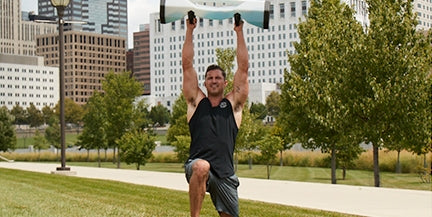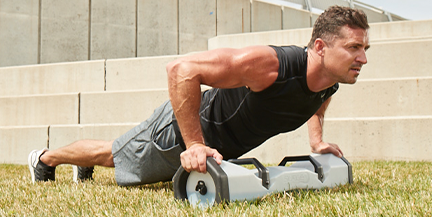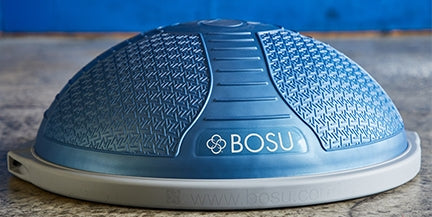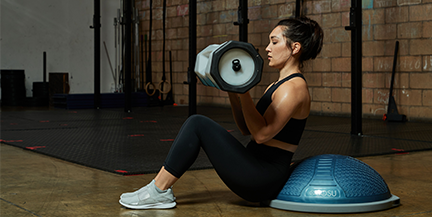Why You Can't Lift More Weight

Here’s what you’re doing wrong. You can’t just rely on a steady diet of sagittal plane dominated squat, bench, deadlift, clean, and snatch lifts.
Why are you tapped out on your PR's? Movement quality and strength/power are built off of a foundation of mobility (positioning) and stability. Your lifting program depends on these same two qualities. If your PR's are plateaued, or you’re struggling as a person new to strength training, your ability to stabilize for the lifting goal at hand probably sucks. You need to train stability independent of your traditional lift program. Another way to say it, stability and accessory training need to be part of your lifting program!
The benefit of training stability throughout the kinetic chain—think shoulders, back, core, hips, knees and ankles—with an unstable load has a direct connection to increasing your traditional lift loads.
Athletes, fitness enthusiasts and those who work out utilizing a CrossFit® training-style are always looking for new ways to:
1) enhance movement mechanics
2) increase power and strength
3) avoid injury
4) lift more weight
Savvy CrossFitters, powerlifters, weightlifting enthusiasts from all sport disciplines, as well as recreationalists.....
need to use Hydro Trainers like the water-filled BOSU® Surge 60 or BOSU® Surge 40 (the smaller version) to help them improve upon traditional lifts and to change-up their normal approach to training. In other words—complementary or accessory exercises—are important to creating a complete approach to training. Using the right kind of accessory exercises can help you to enhance training results, avoid plateaus and minimize overuse injuries by maximizing your ability to train important stabilizer muscles in the body.
Let me guess what you’re doing right. You religiously crank out your squats, dead lifts, bench press, clean and jerk, snatch, and every other lift known to dedicated lifters. And, if you know your stuff, you can site a ton of research that supports max strength as the holy grail that is related to you getting huge, stronger and continuing to increase your ability to lift heavy stuff and improve your maxes.
So, let’s look at what strength get us. A lot! Max strength and ultimately power expression (strength/speed of movement) becomes the foundation for the other key qualities that must be trained (agility, balance, coordinated whole-body movement, stability, mobility, metabolic, sprint, endurance, and plyometric type qualities). Without a doubt, the stronger you are, the more positive impact this has on joint stability, which of course, impacts mobility and optimal positioning/mechanics. So, why worry about accessory stability training if you think you’re strong enough?
“The man,” Greg Glassman, CrossFit® CEO and Founder, said it himself in less than a 100 words.
"Eat meat and vegetables, nuts and seeds, some fruit, little starch and no sugar. Keep intake to levels that will support exercise but not body fat. Practice and train major lifts: deadlift, clean, squat, presses, clean and jerk, and snatch. Similarly, master the basics of gymnastics: pull-ups, dips, rope climbs, push-ups, sit-ups, presses to handstand, pirouettes, flips, splits, and holds. Bike, run, swim, row, etc, hard and fast. Five or six days per week mix these elements in as many combinations and patterns as creativity will allow. Routine is the enemy. Keep workouts short and intense. Regularly learn and play new sports."
What do you think that stuff about gymnastics, for example, is all about? Sure, his message is about new training stimulus, enough volume and intensity, avoiding physical and mental burnout, but hidden in that quote, is a huge focus on the importance of whole-body stability being trained outside of your major lifts. In other words, DO OTHER STUFF!
Top-Down Instability Training with the BOSU® Surge
This is where training with the water filled BOSU® Surge comes in. The use of unstable surfaces and top-down instability devices (e.g., SURGE® Storm 60) can create an outcome of increased muscle activity without necessarily increasing absolute load. Read this as the result being different than trying to lift something heavy (low RM loads).
Yes, you can fill this tool up and make it very heavy (like a barbell or Strongman training log), but when you’re working at 30, 50, and 70 percent of max fillable capacity, the stabilization requirements is actually harder—in a different way— than lifting a fixed heavy load that is not representative of a dynamic load. This is especially true in terms of stabilizing requirements. However, one type of training does not replace the other. Do both! The related training outcome and goals are different. DID YOU GET THAT?
The reason water may change your life is that you have to constantly react to the constantly shifting water-load, which requires whole body stabilization in the shoulders, scapulae, core, hips, knees and ankles. You learn how to turn stabilizing muscles on and off, as well as how to sustain stabilization and position throughout a movement if required. For example, how many times have you lost stabilization/muscle tension of the core, hips and/or shoulders in the basement of a deep squat? Not good. Lifting heavy stuff is complex, especially under heavy loads, and you have to nail the set up and stabilization requirements. If you falter—you get hurt or otherwise fail.
It’s just dumb not to do this type of training, if you want to keep getting better and avoid injury. Here are the benefits and science behind using the SURGE® Storm as part of your complementary training program.
RESEARCH SAYS:
- Strength and stability greatly impact performance and skill acquisition.
- Strength and power expression are critical to other key training outcomes (mobility, stability, balance, coordination, bracing, rotation, metabolic, endurance, and explosive plyometric power.
- Strength and stability acquisition impacts how we move because muscular control (biomotor/neuromuscular) can influence the stability, mobility, balance and positioning interplay—which also affect all other movement chemistry.
- BOSU® Surge training transfers to traditional strength training improvements because it: Involves a mix of balance, reactive and instability resistance training which can lead to higher load traditional resistance training outcome (Behm & Colado 2012). That means you can lift more weight.
How to increase your PR's (key point):
Improved stability at the joints responsible for a complex lift (e.g., squat, deadlift, clean, bench press) will increase one’s ability to lift heavier weight. Period.
So again, let’s get this right. Stability is the ability to stabilize and control body positioning in a global sense (head-to-toe) and/or maintain optimal joint position(s), whether during static or dynamic movement (motor control). That’s important to you! So, train it
Bottom Line:
Unstable resistance exercises require a relatively greater trunk muscle activation, which translates to a greater stabilizing function for the muscles. Instability resistance training (IRT)) exercises can also provide training adaptations for coordination and other motor control issues, which has implications for low back injury prevention. Finally, improvements in postural stability from balance training without resistance, or using submaximal loading (e.g., the SURGE®), can help to improve force/power output (strength x speed of movement). This type of approach can then lead to a training paradigm involving a mix of balance, reactive and instability resistance training (IRT)—which leads you to you be able to lift heavier loads and set new PRs.
Summary: Acquisition of whole-body stability affects all movement chemistry. Training stability specifically under different conditions when compared to max loading and traditional lifting only, is useful in traditional lifting to maintain stability throughout a lift. Think, “I’m deep in the bottom of my squat and don’t want my spine to buckle, pelvis to wink, knees to dive in, or shoulders to rotate inwardly (loss of stabilizing strength). Stabilization is turned on and off throughout a rep, and sustained as needed for relatively short duration; you must develop this skill in unpredictable, reactive settings, versus only under heavy load.
How? Challenge stabilization during movement using submaximal loads. Reactionary and unpredictable forces improve power and strength because of improved stability. That’s why SURGE® Hydro training is so effective.
Stabilization training utilizing top-down instability has high-transfer and correlation to max lifting capacity. Complementary training has a purpose and is foundational to the original CrossFit training models that incorporate a variety of training to completely develop the body. Want to lift heavier weights? Time to add instability training outside of your traditional lifts.
Important aspects of accessory and stability training exercises and equipment is to 1) off-load the body for recovery from heavy lifting protocols, and to 2) simultaneously increase total body stability and body control.
To maximize performance requires a complete approach to training. Top-down instability training with the SURGE® Storm represents one more important piece of the puzzle you need to add to your conditioning program.
Douglas Brooks, M.S., Exercise Physiologist, is Director of Programming for SURGE® and specializes in sport conditioning and strength training.
EndFragment
References (partial):
*Beardsley, Chris Why are strength gains stability-specific? (Strength is specific.)
Study link: https://www.strengthandconditioningresearch.com/perspectives/free-weights-unstable-surfaces/
*Behm, David and Juan Carlos Colado (2012), The Effectiveness of Resistance Training Using Unstable Surfaces and Devices for Rehabilitation, International Journal of Sports Physical Therapy.
Study link: https://www.ncbi.nlm.nih.gov/pmc/articles/PMC3325639/
*Mate’-Munoz, JL et al (2014). Effects of instability versus traditional resistance training on strength, power and velocity in untrained men. Journal of Sports Science Medicine, September, 1-13(3):460-8




